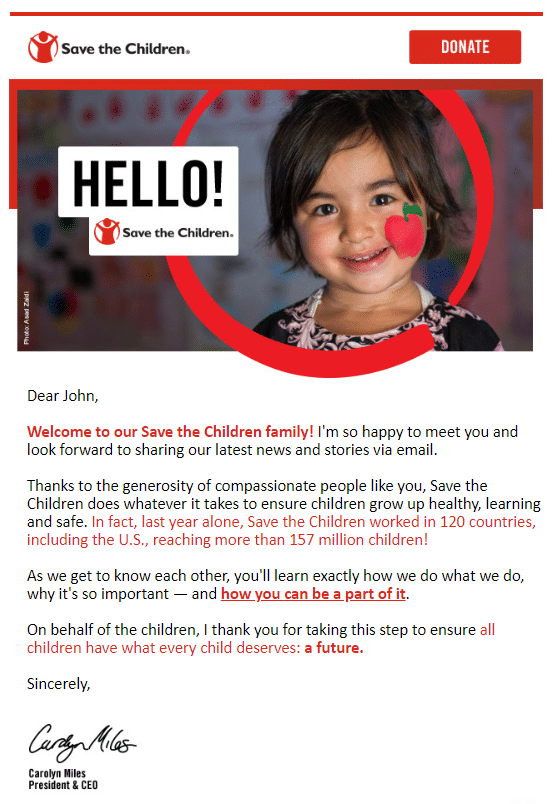Quick Tips to Acquire New Email Leads

Over the past couple of months, virtual fundraising has replaced the walk-a-thons, galas, and in-person ceremonies and events that often bring in big dollars. The immediate restrictions of the pandemic forced nonprofit organizations to critically examine how and where they engage with donors and supporters online.
And we may have mentioned it in previous posts (ok, we’ve mentioned it to death), but we’re wild about optimizing your email strategy because it’s a low cost channel that accounts for one third of all online revenue.
1. Define your goals and determine your audience.
What do you want to achieve by acquiring new email subscribers? Are you looking to convert more donors, gain more volunteers or increase enrollment in one of your programs? Taking the time to assess your primary goal will only help inform your efforts down the road. Your goals will help influence the content you share, make your calls-to-action more clear and actionable, and provide personalized content to your audience(s).
When prospective supporters wish to invest their time engaging with the content you share, they will likely be more willing to invest their funds. So, who are you speaking to?
Begin by defining who your potential subscribers are, develop an offer that will be relevant to this audience, and strategically target them through paid and in-kind channels. If you haven’t already, assess your organization’s donor personas to gain better insight into why your supporters give, and use that knowledge to influence how you communicate the value of joining your organization’s cohort.
2. Develop your offer.
Why should someone join your email list if they aren’t familiar with your organization? What can they hope to gain from joining your email list?
Many website visitors don’t want to share their information unless there’s a guarantee they’ll receive something of value in return. Give these website visitors a reason to return with subscriber-only content. Exclusive newsletters, first access to information you have to share, or free entry to an online event or webinar. Whatever your offer is, make sure it is clear to the user and easily digestible for someone who may be passing through.
3. Make signing up easy.
When we evaluated the email subscription process of 152 nonprofit organizations, we found we were unable to sign up for 30% of email lists. This was either because there was no email sign-up included anywhere on their website, or we could not locate it after searching for a solid five minutes. A missed opportunity that is easily remedied with a sign-up form nobody has to go digging for.
Create a prominent call-out and communicate impact directly on your homepage, either as a timed pop-up or in the footer. This makes it easy for a prospective supporter to relinquish their email address.
Below is an example from Free Geek that is clear, actionable, and communicates the content a subscriber can hope to receive. By requesting a zip code from subscribers, they create a quick and easy way to segment their supporters based on geographic location. This allows them to provide content that is relevant to this audience based on where they may be located, including events and timely updates. This example further allows the user to choose the kind of content that feels relevant to them, which will help deliver personalized information directly to their inbox.

4. Promote, promote, promote.
You’ve established your goal, what you’ll be offering to subscribers, firmly planted your sign-up form on your website, and now it’s time to get the word out. Make sure a prominent link to your homepage is shared in your bio across social platforms, and communicate that you’re looking for email subscribers to share your content, rather than use their email addresses to ping them for money every week. Sumo, GetResponse, and OptinMonster are great free lead-generation options for getting started.
If you’ve got the budget and want to get the word out to targeted audiences based on your ideal donor persona or supporter profile, paid digital is the way to go. Google Ad Grants, Adroll, Facebook and Instagram are all great options to get started. Considering ninety seven percent of first-time visitors leave a website without purchasing products or services, it’s a good idea to re-share your website with folks who may have already landed there. This is known as retargeting, and you guessed it - there’s a blog on that!
5. Build the email subscriber journey.
Cool! You got someone to subscribe to your email list! Now what?
Automation is your friend. The easiest way to welcome new subscribers to your list is to fire-off an automated 3-5 email welcome series that clearly communicates your impact, and shares stories from your organization. Highlight what sets you apart, and personalize your content whenever possible - either segmented by geographic region like the ACLU example above, or by giving level if the new subscriber has made a one-off gift in the past. These details will make your new email subscriber feel valued and increase the likelihood that they’ll choose to stick around.
This example from Save the Children uses powerful imagery, personalization, and expresses gratitude to make the subscriber feel welcome and valued.

6. Find out what works.
Put your content to the test. Improve open rates by launching A/B tests to optimize email subject lines, senders, preview text and time of day. Test your click through rates by messing around with the content in the body of your email (copy, use of imagery, placement and copy of the primary CTA, etc.) and evaluate your results accordingly to improve engagement.
7. Prioritize routine clean-up.
A healthy email list is a successful email list. If you have subscribers that never open or engage with your content, their gathered dust spreads to your open and click-through rates, decreasing the likelihood that your emails will land in a primary inbox. Save time and money by optimizing the list you already have in place, to improve deliverability and reach the supporters that want to read what you have to share! Read our full blog on improving email deliverability here.
A robust email list is only as strong as the content you deliver! Explore our full report on email marketing best practices, based on our content evaluation of 152 nonprofit organizations.





